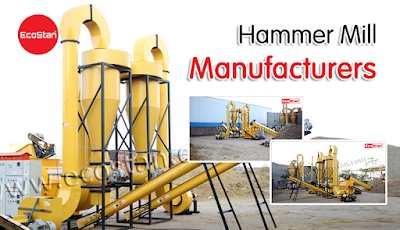In applications requiring particle reduction for material processing, industrial hammer mills are used. The basic hammer mill working concept is constant despite variations in machine designs: uniform size reduction of aggregate raw material is accomplished by repeatedly striking hammers mounted on a rotating shaft. Hammer mill can efficiently grind, shred, shatter, or pulverize any raw material to the desired conclusion upon impact, whether it be titanium or coffee beans.
Basic Milling Technology and the Evolution of Hammer Mills
Hammer
mills have been used for hundreds of years to crush coarse materials into a
fine powder, most notably grains like wheat or minerals like salt. This is
known as basic milling technology. The hammer mill changed from a simple tool
for crushing stone to an advanced machine utilized for material processing by
many industries with the development of industrial milling over the previous
two centuries.
The
core components of the hammer grinder have
not changed after numerous design iterations. On a revolving shaft, a variety
of hammers are supported between rigid plates. The hammers, which can be
mounted horizontally or vertically, freely swing around the shaft to crush the
aggregate material that is fed into the pulverizing chamber from above. Then,
as it passes between the milling components (mantle and concaves), it is
gradually crushed until it ultimately leaves the pulverizing chamber at the
bottom under the effect of gravity.
The
raw material is reduced inside the grinding housing not only by the repetitive
hammer strikes but also by the walls of the grinding chamber and the impact of
a particle on a particle. Once the material has been shrunk to the desired
size, it is discharged through specially crafted steel grates or metal screens.
Gravity makes it simple for heavier and more freely flowing materials to leave
the apparatus. Pneumatic suction is typically used to discharge lower-density
materials. No material can leave the mill until it has gone through the
openings in the steel grate or metal screen. Consistency and uniform particle
size are therefore guaranteed.
The
size of the housing, the rotor, the size of the hammers, the type of screen or
grate, and the rotational speed are other variables in the design variation of
hammer mills. For instance, a rotor's greater RPMs will raise the hammers'
centrifugal force, which will increase the force of each strike on the
material. The desired particle reduction of the raw material supplied into the
housing is accomplished by a combination of the RPMs and energy released by
centrifugal force.
Needs for Hammer Mill Capacity
Any
hammer mill application's capacity requirements are related to the raw material
being processed. The characteristics and physical makeup of the raw material
weigh heavily on the size and type of machine that is required to process it,
both literally and figuratively. Cake mix production does not require the same
hammering equipment as coal processing.
High
capacity and power efficiency are essential requirements for any machine in
today's current industrial hammer mill designs. For all industrial and food
processing applications, however, obtaining uniform particle size is crucial.
The advancement of screen technology has improved machine productivity and
uniform end-product quality. Regard to the Full-Screen design system, in
particular, evenly distributes raw material throughout the whole surface area
of the screen for hammering and grinding, boosting throughput capacity without
raising power needs.
Hammer Mill Design Customization for Your Use
The
design's simplicity allows for customization in the processing of a wide
variety of materials used by numerous industries. Hammer mills are
used by the food, mineral, pulp & paper, chemical, and agricultural
industries to process their products. The raw material can be efficiently
reduced by hammer mills to the required sizes, from medium-sized particles to
ultra-fine particles. Hammer mills are essential to industrial production,
whether they are used to produce food pellets for livestock feed, sugar, spice,
mineral granules, powders for pharmaceuticals, chemicals, meals, or flour.
The
hammer mill, which is the most well-known and popular particle reduction tool,
offers answers for difficult raw material processing problems. In order to
provide businesses with cutting-edge milling solutions and a guaranteed return
on investment in equipment, Prater Industries overcomes these challenges
through the use of cutting-edge technological applications, creative design, a
thorough understanding of industry requirements, and industry expertise.
The bottom line
We
have discussed everything about hammer milling technology in this post, I hope
you like it. Moreover, if you are planning to purchase a hammer mill grinder, reach out to “Ecostan” where you can get briquetting
machines also at affordable rates.



.jpg)




.jpg)